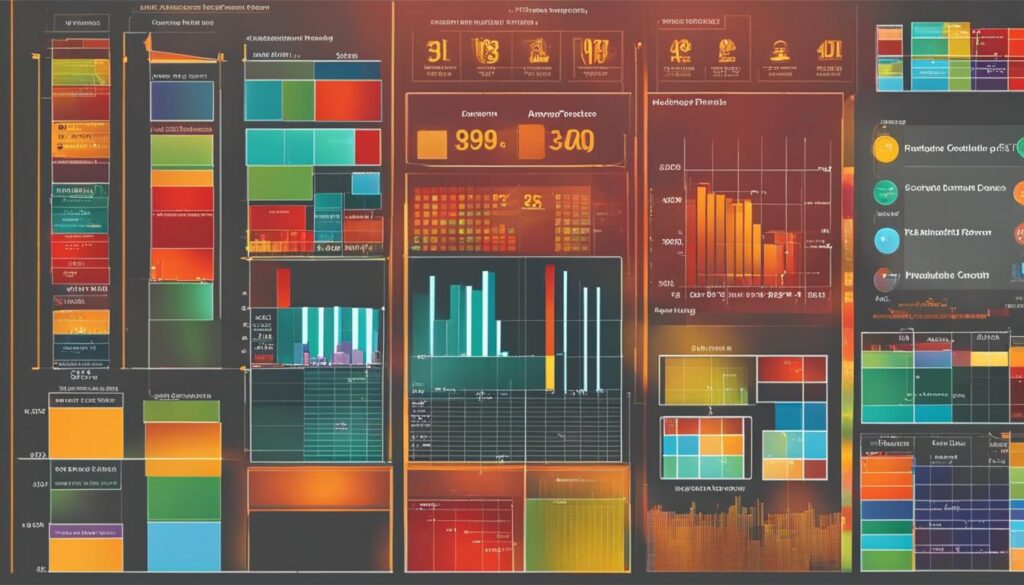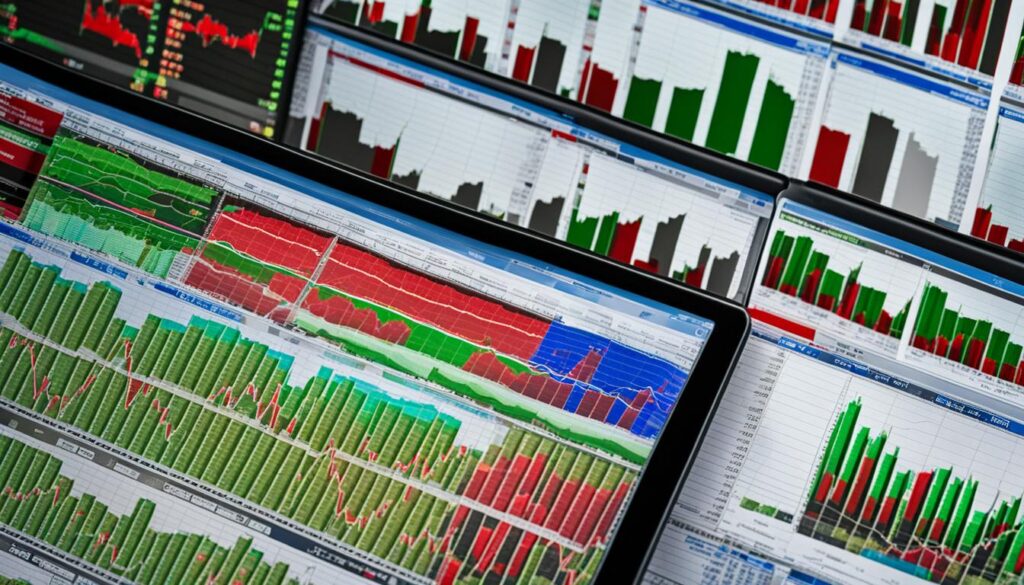In the world of commodity trading, understanding spot prices is a critical component of making informed trading decisions. Spot prices, representing the current market price of a commodity available for immediate delivery, serve as a key indicator of market conditions and can greatly influence trading strategies. By delving into the factors that impact spot prices and staying updated on the fluctuations within commodity markets, traders can gain valuable insights to guide their decision-making process.
Key Takeaways:
- Spot prices reflect the current market price of a commodity available for immediate delivery.
- Factors such as supply and demand dynamics, geopolitical events, economic indicators, and market speculation influence spot prices.
- Analyzing spot prices enables traders to identify trends and make informed trading decisions.
- Understanding spot prices offers benefits such as maximizing profits and managing risk.
- Monitoring tools are available to aid in tracking spot prices in commodity markets.
Factors Affecting Spot Prices in Commodity Markets
Understanding the various factors that can impact spot prices in commodity markets is essential for traders and investors. These factors influence the current market price of commodities available for immediate delivery, and by analyzing them, market participants can make informed decisions to maximize their profits.
Let’s explore the key factors that affect spot prices in commodity markets:
Supply and Demand Dynamics
Supply and demand dynamics play a significant role in determining spot prices. When the demand for a commodity exceeds its supply, spot prices tend to rise, indicating increased scarcity. Conversely, when supply outpaces demand, spot prices may decline as the market becomes oversaturated. It is crucial for traders to closely monitor these dynamics to anticipate price changes and identify potential trading opportunities.
Geopolitical Events
Geopolitical events, such as political instability, conflicts, or economic sanctions, can have a significant impact on spot prices in commodity markets. For example, a geopolitical crisis in a major oil-producing region can disrupt supply, leading to a spike in oil prices. Traders need to stay informed about such events and assess their potential implications on spot prices.
Economic Indicators
Economic indicators, such as GDP growth, inflation rates, and interest rates, can influence spot prices in commodity markets. Strong economic growth often leads to increased demand for commodities, resulting in higher spot prices. Conversely, economic downturns can dampen demand and lower spot prices. Monitoring economic indicators helps traders identify market trends and anticipate price movements.
Market Speculation
Market speculation, driven by investor sentiment and expectations, can cause significant fluctuations in spot prices. Traders should be aware of the impact of speculators on commodity markets and evaluate their influence on spot prices. Analyzing market sentiment can provide valuable insights into potential price movements.
Weather Conditions
Weather conditions, particularly for agricultural commodities, can greatly affect spot prices. Adverse weather events, such as droughts, floods, or extreme temperatures, can lead to crop failures and reduced supply, driving up prices. Conversely, favorable weather conditions can boost crop yields and increase supply, resulting in lower spot prices. Traders should closely monitor weather forecasts and their potential impact on agricultural commodities.
Understanding these factors and their impact on spot prices empowers traders to make informed decisions in commodity markets. By analyzing supply and demand dynamics, staying updated on geopolitical events, monitoring economic indicators, evaluating market speculation, and considering weather conditions, traders can navigate commodity markets effectively to seize profitable opportunities.
“The ability to forecast spot price movements accurately is a key advantage for successful traders in commodity markets.”
Strategies for Analyzing Spot Prices in Commodity Markets
When it comes to analyzing spot prices in commodity markets, taking a comprehensive approach is essential. By employing effective strategies, traders can gain valuable insights into market trends and make informed trading decisions. Here are some strategies to consider:
1. Fundamental Analysis
Fundamental analysis involves evaluating the underlying factors that influence spot prices in commodity markets. This includes assessing supply and demand dynamics, geopolitical events, economic indicators, and market speculation. By closely monitoring these factors and analyzing their potential impact, traders can better understand market trends and anticipate price movements.
2. Technical Analysis
Technical analysis focuses on studying historical price charts and patterns to identify trends and potential future price movements. Traders use various technical indicators, such as moving averages, trend lines, and oscillators, to analyze spot prices and make predictions. This approach helps traders determine entry and exit points, as well as potential levels of support and resistance.
3. Sentiment Analysis
Sentiment analysis involves evaluating market sentiment and investor psychology to gauge the overall mood and expectations of traders. This can be done through monitoring news headlines, social media sentiment, and market sentiment indicators. By understanding the sentiment surrounding a particular commodity, traders can assess whether market participants are bullish or bearish, enabling them to make informed trading decisions.
It’s important to note that a combination of these strategies and the use of appropriate tools and indicators can enhance the accuracy of spot price analysis. Implementing a well-rounded approach will help traders navigate the complexities of commodity markets and increase their chances of success.
Benefits of Understanding Spot Prices in Commodity Markets
Understanding spot prices in commodity markets offers several benefits for traders. These include:
- Analyzing Market Trends: By studying spot prices, traders can gain insights into market trends and how they may impact the value of commodities. This information allows traders to stay ahead of market movements and make informed trading decisions.
- Identifying Opportunities: Understanding spot prices helps traders spot potential buying or selling opportunities in the market. By monitoring spot prices, traders can identify situations where the current price of a commodity may be undervalued or overvalued, allowing them to make strategic trades that can result in profitable outcomes.
- Managing Risk: Spot prices provide traders with crucial information for managing risk. By continuously analyzing spot prices, traders can identify potential risks, such as price volatility or sudden market shifts, and take appropriate measures to protect their investments.
- Optimizing Profitability: Traders who understand spot prices can optimize their profitability by timing their trades more effectively. By monitoring spot prices and analyzing market conditions, traders can enter or exit the market at the most opportune moments, maximizing their potential profits.
- Gaining Competitive Advantage: Having a deep understanding of spot prices gives traders a competitive edge in the commodity markets. This knowledge allows traders to make more informed decisions than their competitors, increasing their chances of success and profitability.
“Understanding spot prices is like having a compass in the complex world of commodity markets. It empowers traders with the knowledge and insights needed to navigate confidently and make strategic trading decisions.”
Example: Benefits of Understanding Spot Prices in the Oil Market
| Benefit | Explanation |
|---|---|
| Analyzing Market Trends | Spot prices can indicate trends in oil demand and supply, allowing traders to anticipate price movements and make profitable trades. |
| Identifying Opportunities | Understanding spot prices helps traders identify favorable buying or selling opportunities based on market conditions and price differentials. |
| Managing Risk | Spot price analysis enables traders to assess the risk of oil price fluctuations and implement risk management strategies accordingly. |
| Optimizing Profitability | By timing their trades based on spot price movements, traders can optimize their profitability in the volatile oil market. |
| Gaining Competitive Advantage | Traders who understand spot prices in the oil market have an edge over competitors, allowing them to make more informed trading decisions. |

Tools for Monitoring Spot Prices in Commodity Markets
Monitoring spot prices in commodity markets is essential for traders to stay updated on market trends and make informed trading decisions. Fortunately, there are several tools available to assist in this process. These tools provide real-time data, analysis, and insights to help traders navigate the complex dynamics of commodity markets.
1. Market Data Platforms
Market data platforms offer comprehensive information on spot prices across various commodity markets. These platforms provide access to historical and current data, allowing traders to analyze price movements, identify trends, and make well-informed trading decisions. Some popular market data platforms include:
- MarketView by IHS Markit
- Bloomberg Terminal
- Thomson Reuters Eikon
2. Price Alert Systems
Price alert systems notify traders when spot prices of a particular commodity reach specific levels. These tools help traders stay updated on market movements and take timely actions. Price alert systems can be customized based on individual preferences, ensuring traders receive only relevant notifications. Some popular price alert systems include:
- Investing.com
- TradingView
- StockCharts.com
3. News Aggregators
News aggregators gather information from various sources and provide traders with real-time news updates related to commodity markets. These tools help traders stay informed about market developments, geopolitical events, and economic indicators that can impact spot prices. Some popular news aggregators in the commodity markets space include:
- Reuters
- Bloomberg News
- Financial Times
4. Charting and Technical Analysis Tools
Charting and technical analysis tools enable traders to visualize and analyze spot price data using different chart types, indicators, and drawing tools. These tools help traders identify patterns, support and resistance levels, and other key technical signals that can inform trading decisions. Some popular charting and technical analysis tools include:
- TradingView
- MetaTrader
- Thinkorswim
By utilizing these tools, traders can stay ahead in the commodity markets and make well-informed decisions based on accurate and timely information. Adequate monitoring of spot prices, coupled with effective analysis, can increase the chances of successful trading outcomes.
Conclusion
Understanding spot prices is paramount for success in commodity markets. By comprehending the factors that influence spot prices, traders can make informed decisions, seize market opportunities, manage risk effectively, and enhance their overall trading performance.
Continuous monitoring of spot prices and staying updated with industry news is essential. Traders should analyze spot prices regularly to identify trends, assess market conditions, and adjust their strategies accordingly. Utilizing effective analysis strategies and monitoring tools can provide a competitive edge in the dynamic world of commodity markets.
In conclusion, a deep understanding of spot prices in commodity markets allows traders to navigate the intricacies of this volatile environment. It empowers them to make informed decisions based on market dynamics, enabling them to optimize their trading strategies and achieve their financial goals.
FAQ
What are spot prices in commodity markets?
Spot prices refer to the current market price of a commodity that is available for immediate delivery.
What factors can impact spot prices in commodity markets?
Several factors can impact spot prices, including supply and demand dynamics, geopolitical events, economic indicators, and market speculation.
What strategies can be used to analyze spot prices in commodity markets?
Analyzing spot prices in commodity markets requires a comprehensive approach. Some strategies to consider include monitoring market trends, analyzing market conditions, and making informed trading decisions.
What are the benefits of understanding spot prices in commodity markets?
Understanding spot prices offers several benefits for traders, such as identifying trends, analyzing market conditions, and making informed trading decisions to maximize profits.
What tools are available for monitoring spot prices in commodity markets?
Several tools are available for monitoring spot prices, including market news updates, trend analysis tools, and monitoring platforms.
Why is understanding spot prices important in commodity markets?
Understanding spot prices is crucial for making informed trading decisions, capitalizing on market opportunities, managing risks, and enhancing overall trading performance.
Source Links
- https://www.bnnbloomberg.ca/pakistan-secures-final-imf-approval-for-700-million-loan-tranche-1.2020887
- https://www.bnnbloomberg.ca/osborne-s-austerity-cost-uk-2-in-lost-gdp-boe-analysis-shows-1.2020883
- https://www.bnnbloomberg.ca/morgan-stanley-to-pay-under-300-million-to-settle-trading-probe-1.2020885
Disclaimer
All information on this website is of a general nature. The information is not adapted to conditions that are specific to your person or entity. The information provided can not be considered as personal, professional or legal advice or investment advice to the user.
This website and all information is intended for educational purposes only and does not give financial advice. Signal Mastermind Signals is not a service to provide legal and financial advice; any information provided here is only the personal opinion of the author (not advice or financial advice in any sense, and in the sense of any act, ordinance or law of any country) and must not be used for financial activities. Signal Mastermind Signals does not offer, operate or provide financial, brokerage, commercial or investment services and is not a financial advisor. Rather, Signal Mastermind Signals is an educational site and a platform for exchanging Forex information. Whenever information is disclosed, whether express or implied, about profit or revenue, it is not a guarantee. No method or trading system ensures that it will generate a profit, so always remember that trade can lead to a loss. Trading responsibility, whether resulting in profits or losses, is yours and you must agree not to hold Signal Mastermind Signals or other information providers that are responsible in any way whatsoever. The use of the system means that the user accepts Disclaimer and Terms of Use.
Signal Mastermind Signals is not represented as a registered investment consultant or brokerage dealer nor offers to buy or sell any of the financial instruments mentioned in the service offered.
While Signal Mastermind Signals believes that the content provided is accurate, there are no explicit or implied warranties of accuracy. The information provided is believed to be reliable; Signal Mastermind Signals does not guarantee the accuracy or completeness of the information provided. Third parties refer to Signal Mastermind Signals to provide technology and information if a third party fails, and then there is a risk that the information may be delayed or not delivered at all.
All information and comments contained on this website, including but not limited to, opinions, analyzes, news, prices, research, and general, do not constitute investment advice or an invitation to buy or sell any type of instrument. Signal Mastermind Signals assumes no responsibility for any loss or damage that may result, directly or indirectly, from the use or dependence on such information.
All information contained on this web site is a personal opinion or belief of the author. None of these data is a recommendation or financial advice in any sense, also within the meaning of any commercial act or law. Writers, publishers and affiliates of Signal Mastermind Signals are not responsible for your trading in any way.
The information and opinions contained in the site are provided for information only and for educational reasons, should never be considered as direct or indirect advice to open a trading account and / or invest money in Forex trading with any Forex company . Signal Mastermind Signals assumes no responsibility for any decisions taken by the user to create a merchant account with any of the brokers listed on this website. Anyone who decides to set up a trading account or use the services, free of charge or paid, to any of the Broker companies mentioned on this website, bears full responsibility for their actions.
Any institution that offers a service and is listed on this website, including forex brokers, financial companies and other institutions, is present only for informational purposes. All ratings, ratings, banners, reviews, or other information found for any of the above-mentioned institutions are provided in a strictly objective manner and according to the best possible reflection of the materials on the official website of the company.
Forex/CFD trading is potentially high risk and may not be suitable for all investors. The high level of leverage can work both for and against traders. Before each Forex/CFD investment, you should carefully consider your goals, past experience and risk level. The opinions and data contained on this site should not be considered as suggestions or advice for the sale or purchase of currency or other instruments. Past results do not show or guarantee future results.
Neither Signal Mastermind Signals nor its affiliates ensure the accuracy of the content provided on this Site. You explicitly agree that viewing, visiting or using this website is at your own risk.



